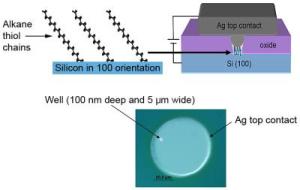|
Related Topics: |
|
Current News |
|
Chemistry A to Z |
|
About Internetchemistry |
|
- Imprint |
|
|
NIST team proves bridge from conventional to molecular electronics possible |
|
The ability to use a silicon crystal substrate that is compatible with the industry-standard CMOS (complementary metal oxide semiconductor) manufacturing technology paves the way for hybrid CMOS-molecular device circuitry - the necessary precursor to a “beyond CMOS” totally molecular technology - to be fabricated in the near future. |
|
Scientists classify crystal structures by the particular plane or “face” cutting through the crystal that is exposed. Most research to date on silicon substrates for molecular electronic devices has been done with a crystal orientation that is convenient for organic molecules but incompatible with CMOS technologies. For their electronic device, the NIST team first demonstrated that a good quality monolayer of organic molecules could be assembled on the silicon orientation common to industrial CMOS fabrication, verifying this with extensive spectroscopic analysis. They then went on to build a simple but working molecular electronic device - a resistor - using the same techniques. A single layer of simple chains of carbon atoms tethered on their ends with sulfur atoms were deposited in tiny 100-nanometer deep wells on the silicon substrate and capped with a layer of silver to form the top electrical contact. The use of silver is a departure from other molecular electronic studies where gold or aluminum has been used. Unlike the latter two elements, silver does not displace the monolayer or impede its ability to function. The NIST team fabricated two molecular electronic devices, each with a different length of carbon chain populating the monolayer. Both devices successfully resisted electrical flow with the one possessing longer chains having the greater resistance as expected. A control device lacking the monolayer showed less resistance, proving that the other two units did function as nonlinear resistors. The next step, the team reports, is to fabricate a CMOS-molecular hybrid circuit to show that molecular electronic components can work in harmony with current microelectronics technologies. This work was funded in part by the NIST Office of Microelectronics Programs and the Defense Advanced Research Projects Agency (DARPA) MoleApps Program. |
|
|
|
|
Related topics - search form: |
|
|
